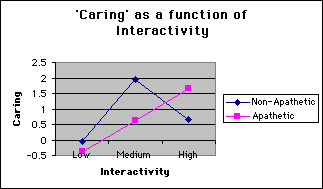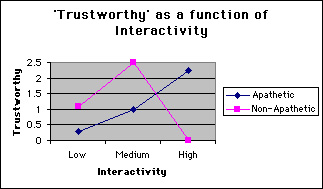Media Effects Research Lab - Research Archive
The effect of website interactivity on political persuasion
Student Researcher(s)
Kenneth M. Hesser (B.A. Candidate);
Justin Brown (Ph.D Candidate);
Sriram Kalyanaraman (Ph.D Candidate);
Faculty Supervisor
FOR A COMPLETE REPORT OF THIS RESEARCH, SEE:
Sundar, S. S., Hesser, K. M., Kalyanaraman, S., & Brown, J. (1998, July). The effect of website interactivity on political persuasion. Paper presented to the Social Psychology Division at the 21st General Assembly and Scientific Conference of the International Association for Media and Communication Research (IAMCR), Glasgow, UK.
INTRODUCTION
Recent years have seen an increase in voter cynicism leading to a gradual loss in voters' psychological affinity for their political representatives. This trend has coincided with a rise in television-based political campaigning. However, emerging technologies offer a means of renewing the confidence of voters in the electoral process by allowing a form of individual contact and interaction not found in present communication campaigns. The rapid proliferation of political websites offers the possibility of direct interactions between political candidates and potential voters. But is this feature of the Web psychologically significant? This study examined the following specific research question: For voters, controlling for apathy, What is the relationship between the level of website interactivity and the degree of psychological affinity toward a candidate on a website?
HYPOTHESES
The theoretical framework for this study was the Elaboration Likelihood Model (ELM). According to the ELM, attitude change can occur when an individual has the motivation, ability, or involvement to process the central arguments of a message (central route). However, when an individual does not have the resources to process the central arguments of a message, attitude change occurs as a result of some simple cue (peripheral route). Based on ELM, and considering website interactivity as a peripheral cue, psychological affinity as an indicator of attitude change, and political apathy as an indicator of (lack of) motivation/involvement, the following hypothesis was generated:
The degree of psychological affinity felt by apathetic voters toward the candidate will be positively related to the level of website interactivity on the candidate's website. However, for non-apathetic voters, candidate perceptions would not vary as a function of website interactivity.
METHOD
Forty-nine participants took part in a between-participants experiment. Participants were randomly assigned to one of three conditions (low interactivity-no extra links; medium interactivity-a link to access extra information about the candidate; high interactivity-a link to send an e-mail message to the candidate).The content and layout was similar across all three conditions. After entering the lab, participants were asked to fill out a pre-questionnaire containing measures of political involvement and knowledge. They were then exposed to the website and asked to go through the information as carefully as possible. After exposure, participants were asked to fill out a questionnaire pertaining to measures of psychological affinity and website content.
RESULTS
The dependent measure of psychological affinity was divided into four factors called 'Caring,' Trustworthy,' 'Responsive,' and 'Charismatic.' The results show that participants who were exposed to higher levels of interactivity developed a positive attitude change toward the candidate by perceiving him to be more caring than those participants who had no interactive links. A significant interaction was also obtained such that, with increasing interactivity, apathetic participants' perception of the candidate's sensitivity (caring), reponsiveness, and trustworthiness tended to increase, whereas non-apathetic participants tended to rate him as less caring, responsive, and trustworthy.


CONCLUSION
An important theoretical implication of the present study is that certain relatively unexplored elements of new media can help redress some of the major problems posed by the rapid rise in mediated political communications. As indicated by the present study, technological features of the new web medium, such as interactivity, seem to have the potential for improving voter affinity toward their candidates. The findings of this study also have implications for other areas of communication research (e.g., advertising). For example, targeted advertising on the internet can potentially stimulate marketplace competition and choice by enhancing the interactivity of their websites.
For more details regarding the study contact
Dr. S. Shyam Sundar by e-mail at sss12@psu.edu or by telephone at (814) 865-2173

